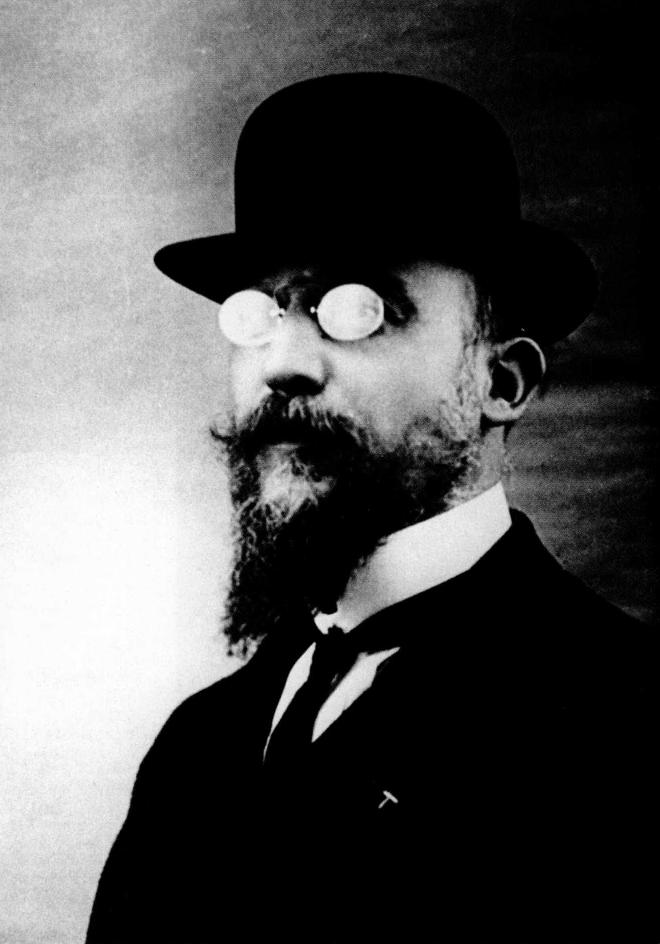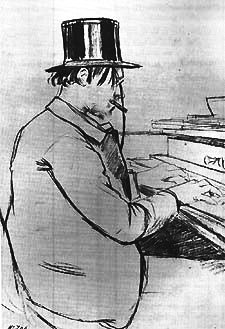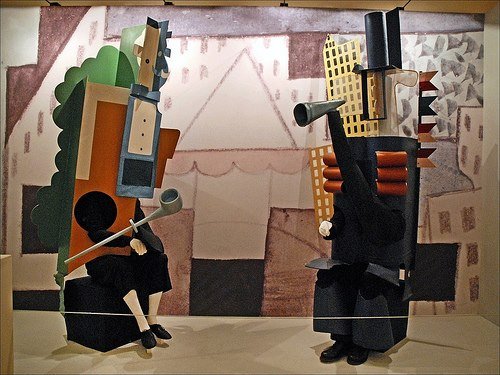Edward Shaw – Essay
"Everyone will tell you that I am not a musician. That is correct. From the very beginning of my career,...

Satie
“Before I compose a piece, I walk around it several times, accompanied by myself.”
—Erik Satie
Erik Satie has often been described as eccentric, indeed, perhaps the most eccentric classical composer ever to have graced this planet. That characterization is wrong because Satie was much more than eccentric. He was disordered. He was bizarre. He was predictably nuts. There have been other musicians who exhibited strange and outlandish behavior—John Cage, Axl Rose, Glenn Gould, and, yes, even Mozart comes to mind. But the antics of these musicians were like nothing compared to Satie’s.
Consider the way he went about his daily life, as excerpted below from his memoirs.
“The artist must regulate his life . . .
“Here is the precise schedule of my daily acts:
“I rise at 7:18 am; am inspired from 10:23 to 11:47. I lunch at 12:11 and leave the table at 12:14. A healthy ride on horseback round my domain follows from 1:19 pm to 2:53 pm. Another bout of inspiration from 3:12 to 4:07 pm. From 4:27 to 6:47 pm various occupations (fencing, reflection, immobility, visits, contemplation, dexterity, natation, etc.).
“Dinner is served at 7:16 and finished at 7:20 pm. From 8:09 to 9:59 pm symphonic readings (out loud). I go to bed regularly at 10:37 pm. Once a week, I wake up with a start at 3:19 (Tuesdays).
“I breathe with care (a little at a time). I very rarely dance. When walking, I clasp my sides, and look steadily behind me.
“My expression is very serious; when I laugh it is unintentional, and I always apologize most affably.
“I sleep with only one eye closed, very profoundly. My bed is round, with a hole to put my head through. Once every hour a servant takes my temperature and gives me another [sic].
“I have subscribed for some time to a fashion magazine. I wear a white cap, white stockings and a white waistcoat.
“My doctor has always told me to smoke. Part of his advice runs: “Smoke away dear chap; if you don’t someone else will.”
Among the things that are verifiable, Satie was not known to own a domain nor, for that matter, a servant or a horse.
Then, there is the matter of his dietary preferences, again excerpted from his memoirs.
“My only nourishment consists of food that is white: eggs, sugar, shredded bones, the fat of dead animals, veal, salt, coconuts, chicken cooked in white water, moldy fruit, rice, turnips, sausages in camphor, pastry, cheese (white varieties), cotton salad, and certain kinds of fish (without their skin). I boil my wine and drink it cold mixed with the juice of the Fuchsia. I have a good appetite but never talk when eating for fear of strangling myself.”
There are some who do not accept Satie’s words at face value and claim his whole diet was so bizarre that he had to be spoofing people when he described it. This is doubtful, given what we have come to know about him. More on this follows.
Perhaps the most conventional thing about Satie was his childhood, and it could hardly be called ordinary. Born in 1866 in Honfleur, a small town in France’s Normandy region, he was the child of a Roman Catholic father, Alfred Satie, and an English Protestant mother, Jane Leslie, who mysteriously was found drowned on the beach when the boy was six. The Satie family had moved to Paris in 1871, but Satie and a younger brother were returned to Honfleur to be reared by his paternal grandparents after Jane’s death. His grandmother died six years later so it was back to his father, who about that time was in the process of marrying Eugénie Barnetche, a pianist and composer of little historical consequence.
Satie disliked his stepmother, and his antipathy was intensified when Eugénie enrolled him in an introductory piano class at the Paris Conservatoire in 1882. Satie regarded the Conservatoire as an ugly building totally lacking beauty both on its exterior as well as inside. He flunked out after initially being described by his teacher as gifted but indolent and then, later in the school year, as the laziest student in the entire college.
Satie began to compose after being ejected from the Conservatoire and started signing his compositions Erik instead of his given name, Eric. He never disclosed the reason for the change, but most likely it was simply an affectation on his part—just one of many to follow.
He reapplied to the Conservatoire in 1885 but the result was the same. If anything, his new teacher was even harsher in his evaluations of Satie and by 1886 he was out again. Unlikely as it may seem, Satie viewed military service as an escape hatch and enlisted in the infantry. He quickly came to the realization that such career was not for him and deliberately contracted bronchitis by positioning himself sans shirt in the outdoors one cold wintry night. He got his discharge.

A Man about Town
In 1887, shortly after his military discharge, Satie moved to the Ninth Arrondissement in Paris. There, he took up lodgings close to the zany and bohemian Chat Noir cabaret, where he became its resident pianist. He loved the café society and unconventional atmosphere and surroundings where he worked. Now free of the restrictions of his youth, Satie created for himself the first of several personas that followed over the years: a long-haired man about town in a frock coat and top hat, this notwithstanding his nonconformist personal leanings.
Satie had a dispute with Chat Noir’s proprietor in 1890 and took another piano job at a nearby café. There he befriended the still relatively unknown composer, Claude Debussy, who shared Satie’s developing experimental approach to musical composition as well as his bohemianism and financial struggles. About this time, he also got involved as the appointed composer and chapel-master for a mystic Rosicrucian sect, Ordre de la Rose-Croix Catholique du Temple et du Graal (Mystical Order of the Rose and Cross of the Temple and Grail) presided over by the audacious Joséphin Péladan. Satie was a member in good standing and believed the sect was a fine place for musicians, artists, and writers. He even wrote a piano composition, “Sonneries de la Rose Croix,” in tribute to it.
By 1892, Satie had written several works, most notably the three piano compositions, “Gymnopédies,” which served as a pathway to later minimalism and experimentation in classical music. But he also promoted a hoax announcing the premiere of his anti-Wagnerian opera . . . which, by the way, didn’t exist. And he challenged the traditional establishment by nominating himself for a seat on the learned and conservative Académie des Beaux-Arts. He was unsuccessful.
He wrote “Vexations” (1893), a single bass phrase accompanied by chords with the instrument unspecified, to be repeated 840 times. Satie’s text instructed, “In order to play the theme 840 times in succession, it would be advisable to prepare oneself beforehand, and in the deepest silence, through serious immobility.” Indeed.
Satie had his one and only love affair with Suzanne Valadon while writing “Vexations.” She was the mother of a boy of unknown paternity, born in 1883, and in the care of her mother while she pursued her work as a painter and artist’s model.[*] After his first evening together with Valadon, he asked her to marry him. Instead, she moved into an apartment adjacent to his single cramped room in Montmartre, and they spent the ensuing six months composing music and painting, sailing toy boats in the Luxembourg Gardens and carrying on a passionate but stormy affair. Then Valadon abruptly moved away, leaving Satie devastated.
In 1893, Satie broke with Péladan to form his own occult sect, Église Métropolitaine d’Art de Jésus Conducteur (Metropolitan Church of Art of Jesus the Conductor). He was the sole congregant of his church and used his position to mount vitriolic attacks through pamphlets and articles against his perceived enemies, especially music critics. Here is a snippet of an example. “To think that we mistook you for a stupid barbarian, for a coward, for a rather silly and pallid reject of literature.” During the two years of the church’s existence, Satie decided to adopt quasi-priestly dress in one more change of image.
The Velvet Gentleman
Despite his affiliation with a radical socialist party, followed by a turn to communism, Satie converted his appearance once again in the mid-1890s—this time to that of a bourgeois gentleman with bowler hat and umbrella. Satie seemingly was obsessed with umbrellas. Over 100 were discovered strewn about his room after his death in addition to eighty-five handkerchiefs and hundreds of letter written mostly to himself and to Suzanne Valadon. To complete the image, he purchased seven (some sources say twelve) identical gray velvet, corduroy suits with money he received from a small legacy. Over a ten-year period he donned one every day until it wore out, then proceeded to the next one. Thus another Satie persona came into being: the Velvet Gentleman.
Notwithstanding the genteel appearance he adopted, Satie was strapped financially most of the time. His money almost depleted, Satie’s friends had taken to calling him “Mr. Poor” in the late years of the nineteenth century. In 1898, Satie moved to an extremely small room in the impoverished commune Arcueil-Cachan, five miles from the Paris city center. It was his only home for the remaining twenty-seven years of his life and visitors were never permitted inside. He walked daily to and from his day job in Paris as a café pianist and composer, openly brandishing a hammer he carried for protection.
Satie earned his living as a pianist and adapter of popular music for piano and voice. But his aspirations changed as he neared age forty, and, in 1905, he enrolled in the music academy Schola Cantorum in Paris where he studied composition, counterpoint, and traditional techniques of classical music. He did much better as a mature student than he had as a youth.
Satie labored as a composer in relative anonymity for years while some of his contemporaries like Debussy and Maurice Ravel, who in some measure had been influenced by him, thrived in the public view. Then, when he was in his mid-forties, he had a breakthrough following a performance of his works by Ravel and by Debussy’s orchestration of two “Gymnopédies” for a concert. Suddenly, Satie was the darling of young musicians—the driving force of a new musical revolution. The press took notice of him. He was finally able to quit his cabaret job and fully devote himself to composition.
Conflicts and Controversy
In 1910, Satie associated himself with the “Jeunes Ravélites”—young composers connected with Ravel—but then expressed displeasure with them and distanced himself because he felt they gave his recent works short shrift. That scenario was repeated in 1918 with a second group, Les Six, with Satie again distancing himself rancorously. He became jealous of other composers’ popularity, especially Ravel and some musicians in Les Six. And he created a rupture with his long-time friend Debussy that persisted until the latter’s death in the year following the break. He refused to attend the funeral.
Satie wrote the music for the ballet Parade, based on a Jean Cocteau story, that premiered in France in 1917. It was an all-star production that included Serge Diaghilev as principal ballet performer. Léonide Massine did the choreography and Pablo Picasso designed and painted the costumes. What could go wrong with such artistic eminences involved in the work? As it turned out, there was bedlam. In reference to the audience reaction, Cocteau later said, “They wanted to kill us . . . I have heard the cries of a bayonet charge in Flanders, but it was nothing compared to what happened that night at the Châtelet Théâtre.”
The audience vented anger at Parade with shouts of “sale boche” (dirty German). It was wartime and French soldiers were dying not far away. Parade appeared flippant and unbefitting the national mood with Picasso’s cubist cardboard costumes and a music score that included typewriters, air raid sirens, ticker tapes, airplane propellors, a lottery wheel, a pistol, milk bottles, and a fog horn. The word “surrealism” was actually used for the first time in the program’s notes. The mounting anger of the audience became an uproar and brawling ensued.

Still, after the curtain drop, music critic and composer Jean Poueigh came backstage, shook Satie’s hand, and congratulated him on the performance. The next day he wrote a scathing review, calling Parade unpatriotic and an outrage on French taste. And he proceeded to slam Satie for “his lack of wit, skill and inventiveness.” Satie responded in kind with several inflammatory hand-written postcards, culminating with this.
“Satie to Monsieur Fuckface Poueigh,”
“Famous Gourd and Composer for Nitwits.”
“Lousy asshole this is where I shit on you with all my force.”
“Never again offer me your dirty hand.”
Challenges to a duel and a possible fistfight ensued. Poueigh sued for slander. At the trial, Cocteau was beaten and arrested for threatening to assault Poueigh’s lawyer with his cane and repeatedly yelling “arse” in the courtroom gallery. Charges against him were subsequently dropped. Satie was sentenced to eight days in jail—which he never served because his charge was also dropped—and given a fine of 1,100 francs, which was paid by a wealthy patron.
Furniture Music and Other Aberrations
Satie maintained his absurdist vision of the world around him throughout his life and up to the end he wove his way between absurdity and heterodoxy. Consider his furniture music, which he wrote in three sets between 1917 and 1923. It was designed to be heard but purposely not listened to. Satie would situate his performers among the audience members rather than assembling them together on a stage, and on occasion became agitated when the audience politely hushed to listen to the music.
His furniture music actually was consistent with his stated self-concept as a non-musician. The following excerpts from his memoirs describe his view.
“Everyone will tell you that I am not a musician. That is correct. From the very beginning of my career, I classed myself as a phonometographer . . . Science is the dominating factor . . . I think I can say that phonology is superior to music. There’s more variety to it. The financial return is greater too . . . with a motodynaphone, even a rather inexperienced phonometrologist can easily note down more sounds . . . And so the future lies with phonometrology.”
Of course, the terms he used in this description are nowhere to be found in conventional dictionary sources. He was especially fond as well of applying nonsensical titles to his works such as “March of the Great Staircase,” “Genuine Flabby Preludes for a Dog” and “Three Pieces in the Shape of a Pear.”
In contrast to his musical iconoclasm, Satie was totally uninterested in modern innovations, like the telephone, radio, and gramophone. As far as is known from his biographical materials, he listened to only a single radio broadcast of a concert, made just one phone call, and never during the course of his life recorded any of his own music.
After many years of heavy drinking, Satie died at age fifty-nine of cirrhosis of the liver. His room in Arcueil-Cachan was finally opened up after his death, revealing squalor. In addition to the aforementioned suits, umbrellas, letters, and handkerchiefs, it disclosed contents that were weird by any definition. A piano covered in cobwebs sat atop another one, which housed among the strings hundreds of rolled-up paper strips with brief, enigmatic phrases, e.g., “My name is Erik Satie, like everybody else.” Many of his compositions were found stuffed into the pockets of the suits, behind the piano, and in various odd places. There was an assortment of drawings of medieval buildings. Dust and debris were everywhere. It presented a startling contrast to his immaculate personal appearance.
*****
Satie’s legacy as a force pointing the way to modernism in twentieth-century music is widely accepted. His own compositions, sometimes controversial and often panned during his career, were not as important as his influence on composers like John Cage and Maurice Ravel, who became acknowledged masters of minimalism and other forms of modernism.
His other legacy is that he established himself as a preeminent musical member of the theatre of the absurd. There are many who say that Satie was just spoofing us, which seems implausible when the individual parts of his life and career are viewed as whole. Everything in his biography points to a bizarre, aberrational person whose antics provoked, mystified, and amused people during his lifetime. Rather than jest being his intent, it was his life per se that proved to be the ultimate jest.
Selected Sources
A Mammal’s Notebook: Collected Writings of Erik Satie. (1997). Translations by Anthony Melville and introduction and notes by Ornelia Volta. Serpent’s Tail; Atlas Arkhive, no. 5.
Alper, Max. (16 June 2016). “Composer Erik Satie Was So Much Weirder than You Realize.” Flypaper. See https://flypaper.soundfly.com/discover/composer-erik-satie-was-weirder-than-you-realize/
Duncan, Julian. (2018). Behind the Red Curtain: Nationalism and Satie’s Parade. See https://diginole.lib.fsu.edu/islandora/object/fsu:654718
“Erik Satie—History’s Weirdest and Most Eccentric Musician.” (7 August 2019). See https://www.youtube.com/watch?v=s_wuzlzhXKs
Gilmor, Alan. (1988). Erik Satie. Boston: Twayne.
Harding, James. (1975). Erik Satie. London: Secker & Warburg.
Orledge, Robert. (1990). Satie the Composer. Cambridge: Cambridge University Press.
Potter, Caroline. (2016). Erik Satie: A Parisian Composer and his World. Woodbridge: Boydell Press.
Predota, George. (2 November 2020). “Composers in the Court Room—Satie versus Poueigh.” Interlude. See https://interlude.hk/composers-in-the-court-room-erik-satie-versus-jean-poueigh/
Rosinsky, Thérése. (1994). Suzanne Valadon. New York: Universe.
“Satie—Memoirs of an Amnesiac.” See https://www.scribd.com/document 215760651/Satie-Memoirs-of-Amnesiac
Whiting, Steven Moore. (1999). Satie the Bohemian: From Cabaret to Concert Hall. Oxford: Oxford University Press.
[*] Her child grew up to become renowned painter Maurice Utrillo. After his birth, Valadon sought out the artists Renoir and Degas for whom she had modeled. Both denied paternity but an artist friend, Miguel Utrillo, told her to use his surname, humorously observing, “I would be glad to put my name to the work of either Renoir or Degas.”



